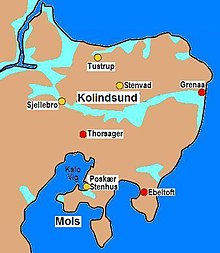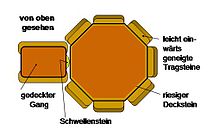Dolmen at Sognevejen in Nødager
Coordinates: 56 ° 19 ′ 5.2 ″ N , 10 ° 37 ′ 47.6 ″ E The dolmen at Sognevejen in Nødager date from the Neolithic Age , around 3500–2800 BC. BC, and are megalithic systems of the funnel beaker culture (TBK). None of the dolmens have been archaeologically examined, but the three structures were protected between 1887 and 1888. Neolithic monuments are an expression of the culture and ideology of Neolithic societies. Their origin and function are considered to be the hallmarks of social development.
location
The parish of Nødager, southeast of Kolind on the Djursland peninsula in East Jutland , is the one with the most complexes in Denmark with around 50 known large stone graves from the Neolithic Age . The area represents the southern counterpart to an almost equivalent concentration near Stenvad in the north of Kolindsund . There are three marked graves along Sognevejen, a little further south is Langdolmen Ildbjerggård and Ginnerup Jyndovnen is also nearby.
The long dolmen
The long dolmen "Kramkisten") also called Skildrup Kramkisten, Krumkisten or Nødager SB 101) has been severely dredged. You can see two systems, but there may be more hidden in the hill. In the middle of the hill is a rectangular, almost man-length ancient dolmen , the capstone (s) of which is / are missing. It consists of three side or supporting stones with a gap in the east. If one assumes that the chamber was originally completely closed, then it is one of the earliest facilities of the TBK.
The northern end of the Langdysse looks excavated. Probably more than six meters of the hill length is missing here. At the edge of the current northern end there is an apparently rectangular chamber. Most of the stones in the complex are not in place and many have been blown up in the past.
The round dolmen
100 m north of the junk boxes is Mårup Runddysse (also called Nødager SB 174), a dolmen with a chamber. The hill of the chamber is again heavily excavated, but some of the remaining curbs are visible along the edge. On the eastern side of the chamber, two remaining bearing stones of the corridor that led into the chamber are visible. The chamber, like many on Djurslands, is a hexagonal polygonal pole , which is formed from five bearing stones (and the passage). On the south side of the chamber is the collapsed capstone that covered the chamber and was provided with bowls in the Bronze Age .
Mejdkirken
About 100 m north is "Mejdkirken", (also called Mejkirke, Mejdkirke or Nødager SB 175) the best preserved and most complete of the three dolmens. It takes its name from the old Danish word "Meje", which means noon. Tradition has it that the pastor of Nødager and Feldballe used to stop at lunchtime at the complex that gave it its name. With its location right next to the road, Mejdkirken is one of the better-known representatives of the Danish megalithic tombs. The only thing missing is the typical intermediate masonry and the capstone (s) of the corridor. The large bearing stones optimally absorb the pressure of the oversized cap stone and both the bearing stones and cap stones point with their flat side towards the chamber. If such stones did not have a naturally flat side, they were sometimes split. The technology for this already existed in the Stone Age.
Polygonal dolmens like the Mejdkirken are for most of the "real" Danish dolmens and the first drawing of the dolmen was made quite early. However, it should not be forgotten that it was originally completely covered by a now excavated mound.
See also
literature
- Peter V. Glob : prehistoric monuments of Denmark. Wachholtz, Neumünster 1968.
- Jakob Vedsted: Fortidsminder og Kulturlandskab. En kildekritisk analysis af tragtbaegerkulturens found material from Norddjursland. Forlaget Skippershoved, Ebeltoft 1986, ISBN 87-981329-5-4 .
Individual evidence
- ^ Johannes Müller : Neolithic Monuments and Neolithic Societies. In: Hans-Jürgen Beier , Erich Claßen, Thomas Doppler, Britta Ramminger (eds.): Varia neolithica VI. Neolithic Monuments and Neolithic Societies. Contributions from the meeting of the Neolithic Working Group during the annual meeting of the North-West German Association for Ancient Research in Schleswig, 9. – 10. October 2007 (= contributions to the prehistory and early history of Central Europe. Vol. 56). Beier & Beran, Langenweißbach 2009, ISBN 978-3-941171-28-2 , pp. 7-16, here p. 15.
- ↑ (Danish: Langdysser) is the common denomination in Denmark for dolmens that lie in a rectangular or trapezoidal barn bed, in contrast to this, round dolmen or Runddysser are those dolmens that lie in a round hill

